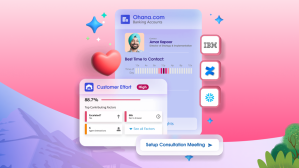When I first started my career in service now 25 years ago, I worked in a call center. Things might’ve been simpler (and more basic) than they are now, but there was still that pressure to create efficient solutions that work—cheaply and at scale—and often at the expense of the customer. At the call center, this translated to “sticking to the script,” doing anything and everything to decrease average call duration, and incorporating technology to scale up our customer service program in ways that often treated our customers like numbers. I know first hand how that led to a frustrating experience for all parties involved—me, my fellow colleagues, and the people we were trying to serve.
Technology has always promised to make things better. In the realm of customer service, that meant simpler, faster, and more convenient.
But that promise has been broken, time and time again—from “the script” to online forms on a company’s “contact us” page. Like an inflexible, impersonal script, an online web form doesn’t often lead to a satisfying resolution. Your message can disappear into a black hole, you receive no notification on when to expect a response, and by the time the response does come through (if it ever does) you have moved on or found another way to get your question answered.
While businesses intend to deploy technology to uplevel customer service, they often prioritize efficiency and cost-saving above all else. As a result, the human element their business was built on in the first place gets lost.
Since my days at the call center, companies have continued chasing the latest technology to boost productivity as their businesses scale up. Automated call distribution directed callers to the next available resource; interactive voice response technology ensured calls were directed to the right department. Companies also leveraged technology to add new customer service channels, including social media, in-app chat, and instant messaging. More recently, advances in artificial intelligence (AI) have enabled organizations to roll out new productivity-boosting tools such as chatbots.
But at the end of the day, deploying these technologies alone does not ensure excellent customer service. An online form cannot show empathy the same way a human can: it does not know how long you’ve searched for an answer, and cannot sense how frustrated you are.
And, with technology at our fingertips, consumers have developed higher expectations of customer service and have a voice in the matter.
They’re no longer willing to listen to automated phone menu after phone menu to try to find the help they need, or explain their problem to three or four different customer service agents until they find one that can help. Not only do 78% of customers expect to solve complex problems by speaking to just one person, they want to do it via channels they’re comfortable with. This means social media and messaging channels like Facebook, Instagram and WhatsApp are no longer just nice for businesses to have, they are a crucial part of a customer service solution. And on those same social media and messaging channels customers are very willing to publicly share their customer service horror stories
78% of customers expect to solve complex problems by speaking to one person.
Putting the human first
To address the growing disconnect between the service customers want and the service they’re receiving, companies must put the focus back on the human connection. Our AI-powered chatbots, for example, have a very long way to go to really understand and empathize with customers. They are not imbued with emotional intelligence. By pairing a human touch with smart technology, companies can deliver what I call Human-Centric Service, in which employees are empowered to deliver intelligent, trusted, personalized service that strengthens relationships and promotes brand loyalty.
Consider this. A customer reaches out to their bank because they lost their credit card. During this interaction, an AI-powered bot gathers the customer’s basic information, such as their name and account details, and then hands the case to a customer service agent so they can complete the customer’s request for a replacement card and answer any complicated questions. While the agent is completing the credit card replacement request with the customer, the system realizes that another credit card is better suited to the customer’s needs—the customer has indicated they are a frequent flyer and there is a card that offers more air miles options. The system alerts the agent, who passes the recommendation on to the customer. The customer ends up with a better credit card and has a positive customer service experience.
In this scenario, companies are better equipped to exceed customer expectations. Agents have the data, tools and insights they need to focus their attention on the customer, and customers have a more satisfying service experience.
So, how do you get started?
To start applying the human-centric framework, organizations need look at their customer service through the human lens of their customer. For starters, pose as a shopper, and rate the experience your receive from your brand. Are you greeted by name, or do you feel like a nameless entity? Most organizations have the technology to see who is calling, so there’s really no excuse for starting conversations with “Who am I talking to?” Personalizing the experience for your customer matters.
To do this though, don’t feel like you need to adopt new technology just because it’s available. Instead, ask what your team members need to be successful. The answer might be AI, or it might be that re-engineering internal processes would be more useful.
Building your human-centric service framework
To embrace human-centric service companies need to focus on four elements.
1. Personal connections matter
When I think back on the positive customer service interactions I’ve experienced as a customer, it’s the person on the other end I remember. Ultimately, it’s the connection between people that makes service great. For organizations, this means ensuring that customer service agents across every point in the customer journey understand the customer’s complete history with the company: what products they’ve purchased in the past, what sort of warranty they have, and if they’ve had a similar problem in the past. Agents must also be empowered to ditch the script, to genuinely listen to and create meaningful connections with customers, and adapt their responses based on the customer’s actions and behavior.
2. Intelligence empowers better service
Health insurance company Humana improves its customer service by arming agents with technology-generated insights they can use to create better customer experiences. To ensure team members show empathy for customers who may be frustrated and worried about the progress of an insurance claim, for example, the company uses emotional intelligence software to analyse stress levels in customers’ voices and guide agents accordingly. This is the kind of technology I believe has the power to complement and amplify the human touch of customer service. Technology improves customer service when machine intelligence is used to guide the human interaction, not when it replaces it entirely. But technology isn’t the only catalyst to creating better service. Providing agents with access to quality training opportunities to develop their soft skills and business acumen can help elevate customer service and differentiate companies.
3. Trust is crucial
Seventy percent of customers say connected processes are very important to winning their business. In our increasingly connected digital world, customers expect consistent experiences. From chatbot to agent, and everywhere in between, companies must create positive experiences. This means delivering the right message at the right time, whether the customer has called a customer service line, completed an online form, or asked a question on Twitter. By showing customers every interaction with the brand will be a positive one, regardless of where it takes place, companies build trust, reduce customer frustration and create a strong foundation for long-term customer loyalty.
4. Inclusive thinking opens opportunities
Technology provides incredible opportunities to create experiences that are more accommodating for a greater number of people. Southwest Airlines realized that by only offering phone support it wasn’t servicing customers with hearing impairments, so it built chat into the company’s mobile app. However, inclusivity isn’t just about making services more accessible for people with disabilities. It’s also about giving people access to information when they need it, in the form they want. This might be through a mobile app because they don’t have a computer, or through social media and messaging platforms such as Facebook, Twitter, Instagram, and WhatsApp.
If this seems like an extensive to-do list, you’re right. But remember, getting a faster horse isn’t the strategy here. It’s about inventing new ways to travel. While efficiency-based strategies and metrics are still important, they’re no longer the only way to measure the success of your customer service. It’s the human connection, supported by technology, that creates great service, allows businesses of all sizes to scale, and builds meaningful customer-company relationships.
Tune in to the Service Keynote at Dreamforce ‘19 to see how trailblazers like Southwest, John Hancock, Pilot Flying J, and Bitty & Beau’s Coffee are delivering Human-Centric Service.




















